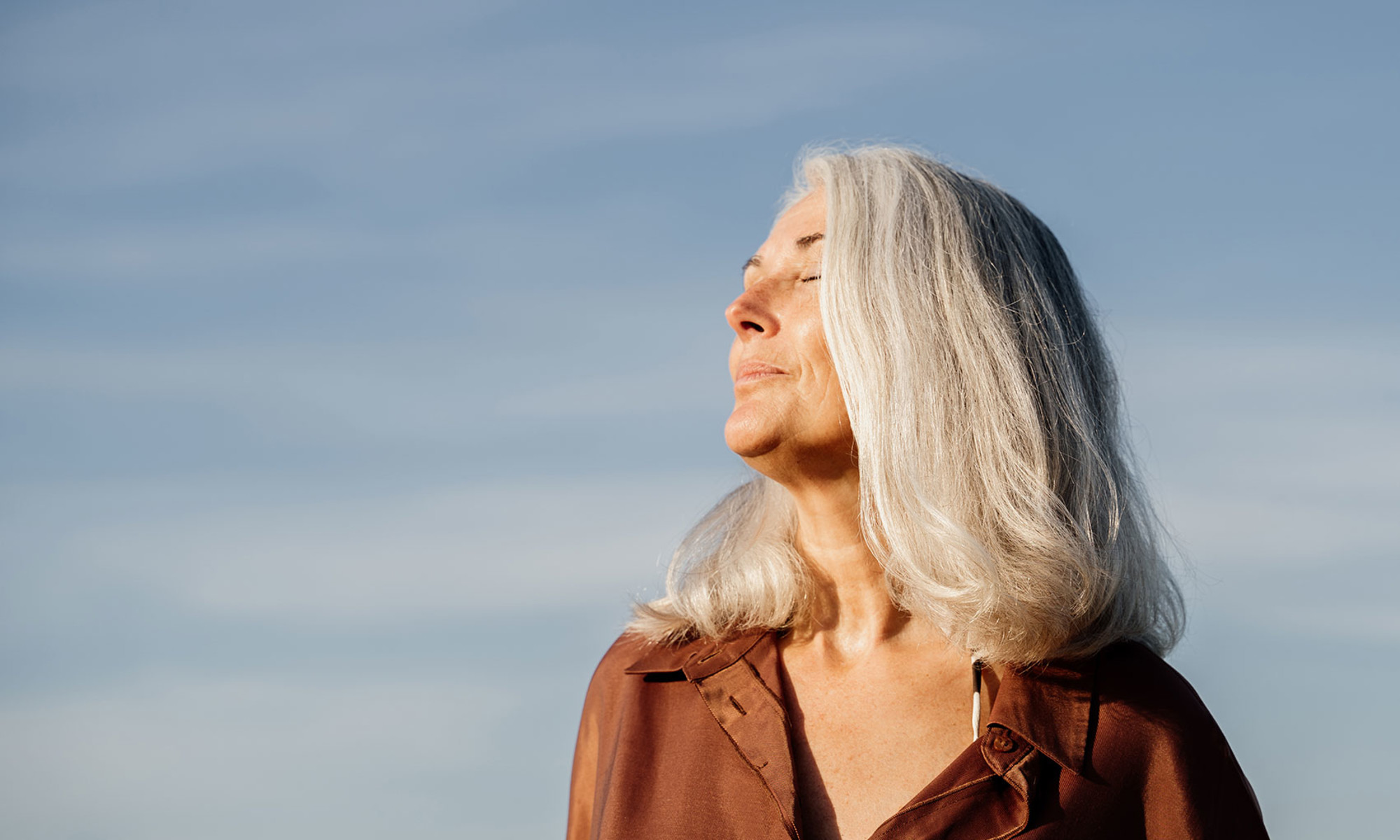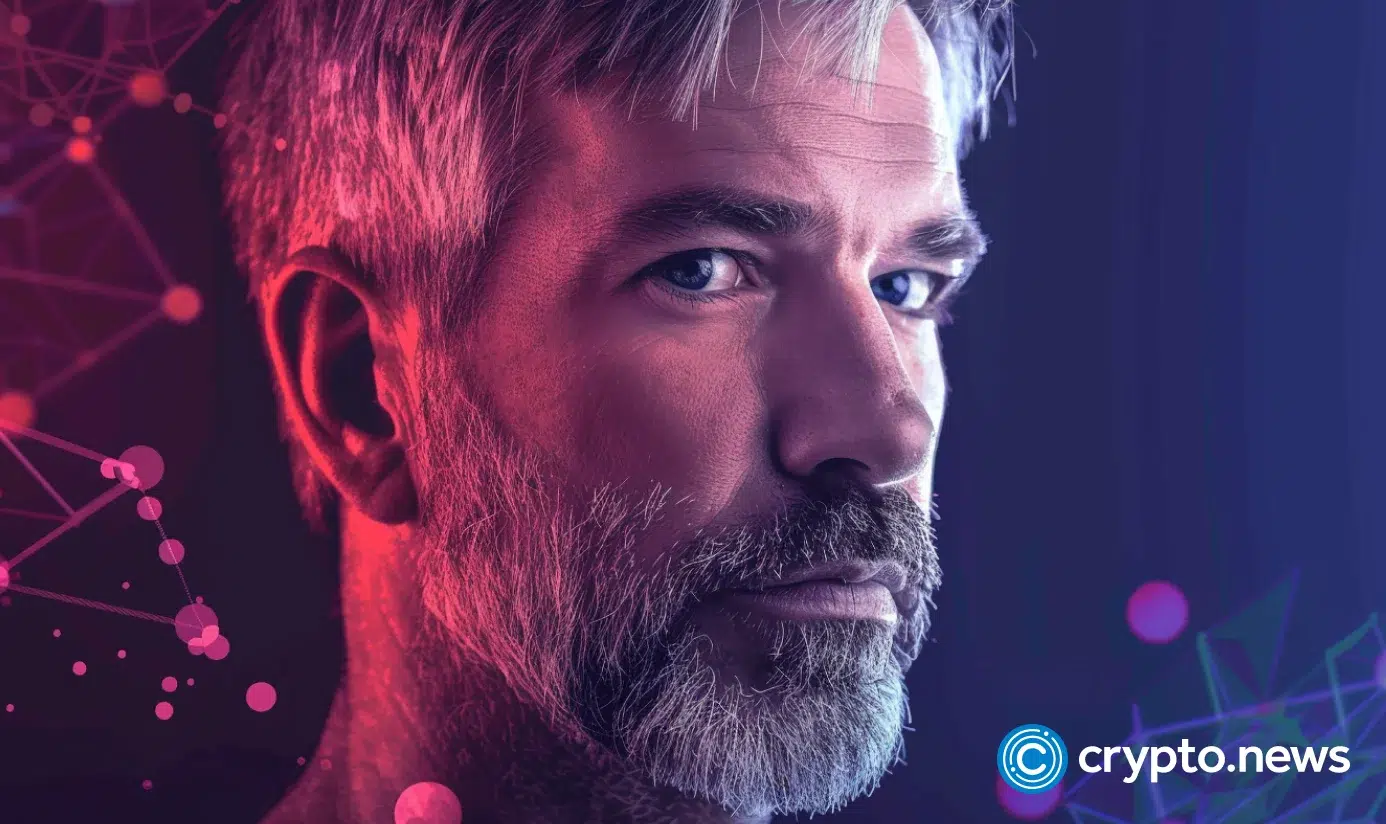Queer-Seeking Mind
A Soto Zen priest on the twin journeys of practice and transition The post Queer-Seeking Mind appeared first on Tricycle: The Buddhist Review.

For me, both dharma practice and transition are relational and creative activities. The more I relax around these identities, the more I notice how much I carry others in how I express them, and the more I see the imaginative and creative play available to me. For example, when I hear recordings of informal talks I’ve given at Mountain Rain Zen Community, I sometimes hear the voices of my teachers, Myoshin Kate McCandless and Shinmon Michael Newton, coming right out of my mouth, down to the smallest of vocal inflections. When I bow, sometimes it’s like my teachers and mentors bow in my body.
I lift my okesa (robe) when I do my prostrations during service, as tanto Bryan Clark did gracefully during my first practice period at Tassajara. I settle my okesa neatly on my lap like Chikudo Catherine Spaeth did when she was my neighbor in the zendo. When I read the Flower Ornament Sutra, I think with delight about my friend Andrew, who stayed up long past fire watch (9:30 p.m., the end of the day at Tassajara), reading it in the dining hall. He was never late for morning zazen the next day, so I’m unsure when he slept. I think he finished all 1,656 pages of Cleary’s translation by the end of the practice period. It’s my favorite sutra; in some ways, it’s become the Andrew Sutra for me.
In the same way, the first time I took estrogen by injection, one of my best friends took his testosterone with me. He showed me how to draw the plunger back just a touch, to save the small amount of medicine in the drawing needle. He teased me gently for being perhaps overzealous with my alcohol swabs. He hugged me as I trembled nervously after my first shot. I think of him every time I take hormones.
When I apply eye makeup—an activity that embodies for me the spirit of play and joy available in gender exploration—I think about an ex-girlfriend who first showed me how to do eyeliner and told me I looked beautiful, even though the tops of my eyelids were as clumpy as a freshly tilled field. Sometimes, even now, it feels like her fingers are gently tugging that line across my eyelid. What could be more intimate than that? More playful and creative?
*
In 2023, I wrote an article for Tricycle: The Buddhist Review about the relationship between my transition and dharma practice. In the article, I mention something a friend of mine, Professor Florence Ashley, wrote in one of their early papers on transition care for young people. They wrote that gender and transition are not acts of unearthing a preconstituted image of the self but instead a project of “actively creating ourselves” in a process they call “creative transfiguration,” which must occur in relationship with others. In the comments section of my piece—unusually sweet and positive for the internet, by the way—someone asked me to say more about Ashley’s quote because it gave them pause. They wrote:
“In order to even conceive of oneself as queer, doesn’t there need to be something preconstituted to spark that conception? If I hadn’t felt a nudge from the woman-self inside me, how would I have known to even consider the path I’m on today?”
In formulating an answer for them, their mention of a “spark” immediately brought to mind the Buddhist idea of Bodaishin—“Way-Seeking Mind.” I thought, “Hmm, yes, there is a spark, isn’t there?” for both gender exploration and the Way-Seeking Mind.
Recently, San Francisco Zen’s Queer Dharma group invited me to offer a short talk. Jisan Tova Green, the organizer, suggested that I could give either a “Way-Seeking Mind” talk or a “Queer Seeking Mind” talk. Instead, I chose to share something about that common spark between these two minds, which is maybe just one mind. I think my experience with each has helped to illuminate the other, so that my Way-Seeking Mind is inevitably Queer, and my Queer-Seeking Mind is inevitably Buddhist.
Like the Way-Seeking Mind, I do not think there is one cause, internal or external, that brings one to question gender and depart the solid earth of one’s assigned identity and out into the uncertain stars of exploration. Some of those causes are innate, intimate, and individual. Others are relational, ancient, shared, and mysterious.
Sometimes, thought experiments (of varying utility) are offered to help people who are wondering if they are “transgender enough.” There’s a wonderful book called Am I Trans Enough? by Alo Johnston. Alo is a Latino trans man and licensed marriage and family therapist in LA.
Although the book is 223 pages long and worth reading, the answer to anyone who feels called to ask, “Am I transgender enough?” is a resounding, “Undoubtedly yes.”
In his book, Alo brings up the “Desert Island Thought Experiment”—would you transition if you found yourself on a deserted island? Would you go through all those awkward stages or the slow progression, far from the eyes of other people? According to Alo, although some people desire that kind of secluded transition, few like it. Alo writes:
“Early pandemic was an opportunity for lots of people to have all the isolation they did or did not want. We were all stuck inside with puzzles and streaming services and not a lot else. As I talked to many trans people at various stages of transition, most of them said that they felt like there was something huge missing. They felt like they had absolutely no social feedback around their gender. They did not have any information about how people were reading them or relating to them.”
He concludes:
“It is impossible to remove other human beings from the equation. We want to be seen and known and understood. We want to connect with other people as ourselves [. . .] integration of all the parts of yourself is then for yourself and for others, not either/or. More specifically, it is so that you can be yourself around others. This does not have to involve any physical or medical transition, but it can.”
Alo connects this idea to the myths of “self-reliance” and “independence” that are so pervasive in Western culture and that we know in our practice of Zen to be a total fabrication. He writes, “The fantasy of complete self-reliance assumes there is a ‘true gender’ deep down, past the reach of our interactions and relationships,” adding that “there is no objective, pure internal self that exists [. . .] we are relational, and our genders are relational too.”
I could say that about my practice as well. I am relational, and my practice is relational too. The important moments of my transition and practice—especially the awkward, silly parts—have been grounded squarely in my relationships with others.
There’s a passage by the founder of Soto Zen, Dogen, in Shobogenzo “Shinjin Gakudo” (Body and Mind Study of the Way) that I love. Dogen writes:
“At the very moment when the aspiration for enlightenment is aroused, the entire world of phenomena arouses the aspiration for enlightenment. Although the aspiration for enlightenment seems to create conditions, it actually does not encounter conditions. The aspiration for enlightenment and conditions together hold out a single hand—a single hand held out freely, a single hand held out in the midst of all being. Thus, the aspiration for enlightenment is aroused even in the realms of hell, hungry ghosts, animals, and fighting spirits.”
My Way-Seeking Mind, this spark, this aspiration, is neither ancient nor new, neither internal nor external. It is not preconstituted, nor is it merely arising now.
The Way-Seeking Mind is my hand interlinked intimately with the hand of all existence, stretching out through space and time, through grief, loneliness, fear, and despair. One hand together, reaching through hell.
How could it be anything but mysterious? How could it be anything but relational?
In accepting this hand, this spark, this mind—whether it is the request of practice or the necessity for me to explore gender—the path was and is not set neatly or linearly, as much as it is a vast winding mountain with countless trails, diversions, wonders, and mysteries.
For me, both the Way-Seeking Mind and the Queer-Seeking Mind are a step out into a vast and limitless expanse of possibility. When I think about practice or gender, both feel like gazing up at the night sky at Tassajara or the brilliant blue of the Salish Sea at home in British Columbia. There’s no end to it, no boundaries.
So even for those of us who find ourselves settling—for a moment or even a lifetime—on the solid earth of some finite understanding, whether in practice or transition, there seems to be an awareness that the possibilities of gender, embodiment, and existence are infinite.
Dogen writes, “When dharma fills your body and mind, you feel that something is missing.” In that same way, transition and Zen practice have gradually eroded my sense of myself as a concrete, independent, and self-reliant individual.
One way I like to think of this in my practice is to consider the operation of rebirth not just on the familiar scale of my own life but the birth and death happening every moment in my cells and tissues, the neural connections of my brain, the thoughts, visions, and dreams leaping to life in my mind almost as quickly and vibrantly as they disappear. This is not necessarily a nontraditional view. In our school of Buddhism, two kinds of life get talked about. The first is ichigo-shoji (the idea of a span of life between birth and death). Ichigo-shoji was written on the death certificates I handed to grieving families when I was an apprentice to a funeral director. But there’s also setsuna-shoji (moment-by-moment life and death).
Dogen emphasized the ephemeral beauty of these momentary lives when he wrote in Shobogenzo Shukke Kudoku (Virtue of Leaving Home) that “during one click of our fingers, sixty-five of these moments of time arise and disappear, but we are in the dark about this, due to our lack of awareness. Within the period of a single day and night, there are over sixty-four hundred million of these moments during which our five skandhas arise and disappear, but we are unaware of this. How sad that even as we arise and vanish, we ourselves are unaware of it!”
What does bringing awareness to this flowing stream of birth and death look like? Mountain Rain’s founding teacher, Norman Fischer, wrote about this stream, and a possible conception of rebirth, in his title What is Zen: Plain Talk for a Beginner’s Mind:
“For Zen, the question of rebirth presents no problem. Zen handles the question in the way it handles everything—by deconstruction, by paradox.
[Illustrating this, there is a] classical Zen story of Kuei-shan Ling-yu, who tells his disciples that when he dies he will be reborn as a water buffalo on the side of the hill. The disciples will know it’s him, he says, because the buffalo will have emblazoned on its side the Chinese characters for “Kuei-shan.” He then poses a question for them. “If you say it is a water buffalo, you will be wrong. But if you say it is Kuei-shan, you will also be wrong. What is it?” This story isn’t a joke. Kuei-shan is pointing out that life, death, and rebirth are ineffable realities not subject to our facile black-and-white conceptual framework.”
*
An example of setsuna-shoji came up in my practice about three months after I started hormone therapy.
Without any kind of planning on my part, my decision to begin medically transitioning came at the perfect time for me to spend a practice period residing at City Centre. I feel so fortunate that these two aspects of my life collided, allowing me to observe the changes in every cell of my body through the lens of disciplined practice.
For many years, I had sat zazen and watched the desire to end my own life arise, acknowledged it with resigned compassion, and returned to my vow to be present and aware, to live. A month into that practice period, I noticed I hadn’t thought of ending my life in many days. I felt, for the first time, comfortable in my skin. My mind and emotions were beginning to change, as though during my entire teenage and adult life, a radio had been spewing out bad music—something awful like post-grunge meets ska—and someone had suddenly turned it off.
One night, I stood sleepily in the small kitchen after a dharma talk, waiting for my ginger tea to steep. I looked down at my blue rakusu, which I received from one of my teachers in 2018. I looked at the irregular stitches and the spot of oatmeal from the breakfast after my first whole night sitting during Rohatsu. The faded spots where fingers slick with sunscreen had handled it during a sweaty, joyful summer retreat. I suddenly realized, “Someone else sewed this. Someone with a different name. Someone who woke up some nights in tears and didn’t know why. Someone courageous enough to do the scariest thing ever.” I felt a deep gratitude for this person—this person who was me but wasn’t me. A white buffalo gazed sympathetically at me through the temple window and clambered up Paige Street and into the night.
I don’t think my experience is unique—I think I was just lucky enough to notice something that happens to us every moment of every day. For a second, Dogen didn’t even have to pity me as I became aware of one of my countless births and deaths.
But when I remember this experience, what strikes me is that the spark of Queer-Seeking Mind was also a spark of inclusive self-compassion—feeling the blurred margins of my self at that moment, understanding my experience as an individual at that moment to be temporary, transitory. This recognition didn’t erase the particularities of that experience. Instead, it gave me the spaciousness to feel genuine gratitude and care for this past self, step back, and love my present self from a perspective of equanimity.
For those of us who have had our identities challenged, denigrated, denied—I think there’s a fear of the softening and enlarging of the self that can happen with practice. At least, that’s something I’ve heard from a few queer folks in my Zen community, and an experience that I have struggled with—this idea that the request of practice is a denial of identities and lived experiences.
Personally, there was a time in my practice when I made use of Zen as a way to avoid exploring gender, and sometimes even as a way to criticize myself for the suffering and joy that arose from that exploration. To feel dysphoria, to wish for my body and mind and feelings to feel different, to feel euphoria, to delight in feelings and experiences that confirmed my womanhood—these felt to me like a failure of my practice.
I’m so glad I’m over that.
I’ve come to feel that impermanence, the changeability and insubstantiality of self, is not about the dissolution of self but about fully embracing life as a whole and complete person.
In his book Opening the Hand of Thought, Kosho Uchiyama Roshi says that zazen is “living out your own life through all the circumstances you may encounter,” adding that, “when we do zazen, we personally experience this clearly; we become nothing other than ourselves! Though we become nothing other than ourselves alone, the whole world is contained within that self.”
I’m at a point now where I wonder if the impermanent, insubstantial, changeable way of things is the gravity that carries me forward on my twin journeys of practice and transition—the medium through which that hand reaches out, together with my own, toward a life of joy, compassion, and identity with all beings.
♦
This article was excerpted and adapted from a talk originally prepared for and given to SFZC Queer Dharma on September 7, 2024, and first published on River Shannon’s Substack, Unfolding Practice.

 ValVades
ValVades 
































